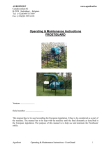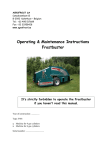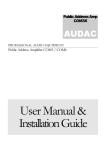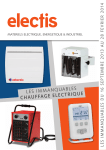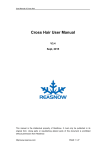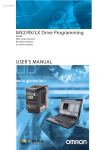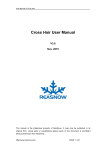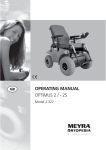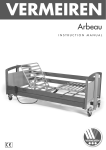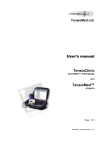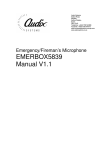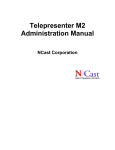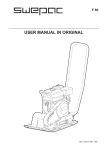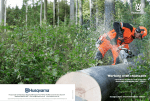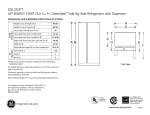Download User Guides - Orchard Agrimek
Transcript
~1~ Operating & Maintenance Instructions FrostGuard GC20 It’s strictly forbidden to operate the FrostGuard if you haven’t read this manual. Year of construction:.......................... Type: GC 20 Serial number: .................................. This manual has to be used according the European legislation. It has to be considered as a part of the machine. The manual has to be kept with the machine until the final dismantle as described in the European legislation. The purpose of this manual is to help use and maintain the FrostGuard safely. The user manual has to be kept by the owner or the user on a safe, dry and sun protected place on the working area. It must always be available to consult. When the manual is damaged, the user has to ask Agrofrost for a new one. Copyright AGROFROST NV 2012. All rights are strictly preserved. Reprinting, coping, changing, republishing and disclosure are strictly forbidden by all means without recognition of Agrofrost SA. Frostguard - Operating & Maintenance Instructions – www.agrofrost.eu ~2~ Furthermore Agrofrost SA has the rights to change this publication and fulfil changes to the content without preannounce of such changes or rework. POINTS OF ATTENTION IN THIS MANUAL Hint: to give suggestions and advice to ease certain tasks Attention: a remark with extra information to call your attention for possible problems Warning: to call your attention for avoiding danger ABOUT THE USERS OF THE FROSTGUARD Required user characteristics. Persons who are allowed to drive a tractor by law and are familiar with the driving of a tractor may operate the FrostGuard. They have to be at least 18 years old and be able of all their physical and psychical capacities. They must read this manual before using the FrostGuard. Someone who has not read this manual cannot use the FrostGuard safely. The profile of the user. This user manual is created for two main groups: - The user / driver: the person who operates the FrostGuard - The mechanical maintainer: the person who does the assembling, maintenance and repairs Members of both groups have to read this manual attentively before using the FrostGuard and before doing any repairs or maintenance on the FrostGuard. Frostguard - Operating & Maintenance Instructions – www.agrofrost.eu ~3~ 1 INTRODUCTION ............................................................................................................ 4 1.1 1.2 1.3 1.4 2 SAFETY ............................................................................................................................ 6 2.1 2.2 2.3 2.4 2.5 3 First use ...................................................................................................................................12 Preparation for use of FrostGuard ...........................................................................................12 OPERATING THE FROSTGUARD ........................................................................... 13 5.1 5.2 5.3 5.4 5.5 6 Transport .................................................................................................................................10 Storage ....................................................................................................................................11 FIRST USE AND PREPARATION ............................................................................. 12 4.1 4.2 5 Important: Not to be used in closed areas .................................................................................6 Safety and health risks: residual risk.........................................................................................6 Safety precautions .....................................................................................................................8 Safety advice on maintenance, repairs and storage...................................................................9 Explanation pictograms.............................................................................................................9 TRANSPORT AND STORAGE ................................................................................... 10 3.1 3.2 4 Description of the machine and its most important parts..........................................................4 Intended conditions of use of the FrostGuard ...........................................................................5 Improper use of the FrostGuard ................................................................................................5 Positioning the FrostGuard in the orchard, vineyard or field ...................................................5 The controls.............................................................................................................................13 Startup procedure ....................................................................................................................14 During operation .....................................................................................................................15 Stopping procedure .................................................................................................................15 Replacing the gas cylinders during operation .........................................................................15 MAINTENANCE – CLEANING ................................................................................. 16 6.1 Cleaning ..................................................................................................................................16 6.2 Maintenance ............................................................................................................................16 6.2.1 Transmission belts...............................................................................................................16 6.2.2 Burner..................................................................................................................................16 6.2.3 Fan and transmission shaft ..................................................................................................16 6.2.4 Engine .................................................................................................................................17 6.2.5 Fuel engine ..........................................................................................................................17 6.2.6 Annual maintenance to prevent corroding ..........................................................................18 6.2.7 Gas hoses: obligatory to replace every 5 years ...................................................................18 7 WARRANTY - SCRAPPING - SPARE PARTS LIST .............................................. 19 7.1 7.2 7.3 8 Warranty..................................................................................................................................19 Scrapping ................................................................................................................................19 Spare parts list .........................................................................................................................19 EC DECLARATION OF CONFORMITY ................................................................. 20 Frostguard - Operating & Maintenance Instructions – www.agrofrost.eu ~4~ 1 Introduction 1.1 DESCRIPTION OF THE MACHINE AND ITS MOST IMPORTANT PARTS The FrostGuard is a rotating motor driven machine equipped with a powerful fan and a gas burning installation. It generates a powerful lateral laminar flow of hot air in order to treat crops and trees with. Some of the most important parts are: The fan with built in burner ring: the fan uses the rotational energy received from the engine to move large quantities of air. By using the heat energy provided by the built in burner ring, the FrostGuard heats up the air it displaces. Side outlet of the fan: this outlet ensures laminar flow. It is not possible to protect this outlet more without influencing the initial operation of the machine. Therefore a residual risk remains. Gas cylinders: the machine makes use of the combustible gas these cylinders provide to heat up the air. They need to be installed on the gas bottle holder that is provided with the FrostGuard. It is important that the gas bottle holder is attached with the machine via the silencer and the exhaust pipe. Fixing/ Lifting eye: you have to use this tool for fixing the machine firmly during transport. You have to use all these eyes at both sides of the machine if you want to hoist the machine. Engine: the engine is running on propane gas (or gasoline) and provides power for the fan. The design of the FrostGuard is in a way that the inlet air provides cooling for the engine. The alkylate based fuel (gasoline version only) is stored in tanks in the side panels. Frostguard - Operating & Maintenance Instructions – www.agrofrost.eu ~5~ 1.2 INTENDED CONDITIONS OF USE OF THE FROSTGUARD The FrostGuard is a rotating motor driven machine equipped with a powerful fan and a gas burning installation on the side. It generates a lateral laminar flow of hot air in order to treat crops and trees with. Alkylate based fuel (e.g. Aspen) is mandatory for this machine (if not running on propane gas). This type of fuel prevents blockage of the carburettor. The FrostGuard may only be used outdoors where there is natural ventilation. At the end of the season, the FrostGuard needs to be stored indoor with the gas cylinders removed from the machine. The gas cylinders have to be stored outside, according to the prescriptions of the fire insurance company. 1.3 IMPROPER USE OF THE FROSTGUARD The FrostGuard may not be used indoors or outdoors in a closed area without natural ventilation. It is strictly prohibited to use the machine if not all safety requirements as described in Chapter 2, are complied. The FrostGuard cannot be used, when one or more of the following guards are missing, loose, damaged or incomplete: the complete gas cylinder holder with silencer; all the guards; Furthermore, it is strictly prohibited: - to use the FrostGuard on slopes with gradients of more than 8%; - to carry a charge of any kind in any circumstances on the machine; - to transport persons or loads on the machine; - to weld or to make any changes whatsoever on the original design of the FrostGuard. 1.4 POSITIONING THE FROSTGUARD IN THE ORCHARD, VINEYARD OR FIELD Ask your dealer for the ideal setup of the machines. Or send a plan of your orchard/vineyard by e-mail to [email protected] . Agrofrost will send you back instructions for the ideal set up. Frostguard - Operating & Maintenance Instructions – www.agrofrost.eu ~6~ 2 Safety In this chapter, the FrostGuards most important safety aspects will be explained. It is essential that everybody who works with the FrostGuard reads attentively the contents of this chapter. The most important safety and health risks related to using the FrostGuard are listed in paragraph 2.2. The FrostGuard is designed to reduce these risks as much as possible. The safety precautions to be observed and to be taken by the FrostGuard user are listed in paragraph 2.3. The safety advices for technicians come up in paragraphs 2.4 and the symbols found on the FrostGuard are clarified in paragraph 2.5. 2.1 IMPORTANT: NOT TO BE USED IN CLOSED AREAS It is not allowed to use the FrostGuard in a closed area, because of three reasons: - The burner consumes oxygen. So the supply of fresh air is very important. - The engine produces carbon monoxide. This is an odorless, colorless, poisonous gas. Breathing carbon monoxide can cause nausea, fainting or death. - If gas would escape because of a gas leak, it could create life threatening situations in a closed area because of the danger of explosions. 2.2 SAFETY AND HEALTH RISKS: RESIDUAL RISK The residual safety- and health risks related to parts of the FrostGuard are being mentioned below together with a series of measures that are taken to keep these residual risks as little as possible. Presence of propane gas (= combustible) - Risk of explosion in closed space has been averted by use of safety components and the explicit ban on indoor use. - Also the design of the FrostGuard reduces the risk of the presence of accumulated gas. If the FrostGuard is working with all the cover plates present, the inlet air stream will flow throughout the FrostGuard and carries any possible accumulated gas through the fan before ignition has started. - Various safety components are built in the gas installation. The suppliers of these components ensure that have been inspected by an official inspection service. - Ignition of the gas is built in and works from a distance. The user ignites the machine in a safe way from a safe position. - An electric valve is built in. This valve needs to be opened manually, and it stays only open automatically by the heat sensors after ± 30 seconds. - When the energy supply is cut off, the machine cannot function, because the pilot will have gone out. Frostguard - Operating & Maintenance Instructions – www.agrofrost.eu ~7~ Presence of high pressure gas There are 2 valves for pressure relief. - The first one is located at the bottom of the machine and reduces strongly the gas pressure that is inside the gas cylinders. This valve is fixed and built in. There is no need to alter the preset value. - The second valve is the main valve. This is a manual valve and is used to adjust the air temperature. Presence of high temperatures - At the ignition on the inlet of the burner ring: the ignition is entirely shielded from contact with the user by the isolated inlet. There's no chance for contact with the ignition flames. The walls of the inlet chamber are isolated with glass wool to reduce the noise and to prevent the sides from overheating. - At the outlet of the fan: when the machine is working, the flow of the air prevent touching the inside of the outlet of the fan. When the user stops working with the machine, he must leave the ventilator running for at least 3 minutes, so the additional outlet of the fan can cool sufficiently (30°C). There is a thermometer and a warning pictogram on the outlet of the machine. So the user can check the temperature before he starts to store the outlet. However, there is no shielding to prevent the user to touch the fan outlet of the machine. Uncontrolled use of the FrostGuard - The use of control panels simplifies and secures the operation of the FrostGuard. Explanation is given in chapter 5. - There are 2 heat sensors incorporated. a. There is one safety heat sensor located on the side of the outlet of the fan. This sensor activates the present electrical circuit that operates like a hold switch for the gas supply. This switch activates the electrical circuit by 70° C. But more important: it deactivates the circuit if the temperature drops beneath 50° C or. So the supply of gas gets interrupted by low temperature readings. If the burner breaks down or the burner flame gets out for some reason, the gas supply is cut off. b. There is a second heat sensor located 10 cm above the first sensor. This sensor activates an acoustic sound system when the temperature during operation drops under 70° C or exceeds 120°C. - There is a wind detection system incorporated in the outlet of the FrostGuard. When the motor stops running, the wind detection system shall cut off the supply of gas. Presence of rotating parts - Covering the exhaust pipe isn’t possible because this exhaust is needed for applying a laminar air flow. Because of this, it is possible a grown up puts his hand at the entrance of the exhaust and is able to reach the blade wheel of the fan. We can only apply the necessary safety stickers to prevent such an act. EXTRA WARNINGS: DO NOT PUT YOUR HANDS IN THE EXHAUST FAN Dangerous situations involving third parties Frostguard - Operating & Maintenance Instructions – www.agrofrost.eu ~8~ A fixed safety zone of 30 meters around the FrostGuard has to be observed: no other people but the user may be in that safety zone. When disconnecting the gas supply, for any reason, always keep the machine running for another 3 minutes in order to remove any amassed gas and to cool down the heat sensors of the electric valve. Only after the electric valve has closed automatically other people may enter the safety zone. 2.3 SAFETY PRECAUTIONS Before use First read attentively the instructions in the manuals of both the FrostGuard and the tractor. The user has to be acquainted with operating the controls of both. The guards must all be in their place. The FrostGuard cannot be used, when one or more of the guards are missing, loose, damaged or incomplete: the complete gas cylinder holder with silencer; all the guards; Check the gas connections for leaks with the leak spray. During use When the machine is activated, make sure that no other people come within the safety zone, being 30 meters around the machine. Keep children away from the machine. Do not let then without supervision if they could come within the safety zone, being 30 meters around the machine. Remain within hearing distance when the machine is working. The acoustic alarm could go off, indicating that there is need for intervention. Do not let the machine work without all the cover plates: it is important for the cooling of the engine that all the plates are in place. Beware of the fact that the entire machine is rotating. So don't come to close. You might influence the working of the machine. Always keep engine running at a stable pace. When the number of revs lowers, the exhaust temperature will rise sharply. The guards on the exhausts will also heat up, which results in potential danger of burns. If the flame should go out for any reason during operation, it must not be lit immediately. First, the ventilator must run for minimally 2 more minutes, so the heat sensors can cool down and the electric valve will close automatically. When changing the gas cylinders and ending operation Keep the fan running for at least 3 minutes, so the heat sensors can cool sufficiently. Always close the gas bottles after use, and also before changing them on the machine. Use the leak spray to check the connections of the gas cylinders for leaks. Frostguard - Operating & Maintenance Instructions – www.agrofrost.eu ~9~ 2.4 SAFETY ADVICE ON MAINTENANCE, REPAIRS AND STORAGE All screws and nuts must be tightened firmly, in order to keep the machine safe and in optimal condition. The FrostGuard must be stored inside, but not with the gas cylinders on it. Store the FrostGuard horizontally in a dry place. Always use genuine spare parts. Using non genuine spare parts can enhance the chances of damage, even if they fit on the machine. Replace damaged warning and instruction stickers. All the flexible gas hoses have to be replaced every 5 years. 2.5 EXPLANATION PICTOGRAMS FLAMMABLE MATERIALS CAUTION DANGER HOT SURFACE MOVING PARTS FIRE: OPEN FLAMES AND SMOKING PROHIBITED Frostguard - Operating & Maintenance Instructions – www.agrofrost.eu ~ 10 ~ 3 Transport and Storage 3.1 TRANSPORT Fixing / lifting eyes: you have to use this eye for fixing the machine firmly during transport or for hoisting the machine. When you want to transport the machine by road, you have to fix the machine firmly onto the transportation vehicle. You have to attach a steel chain or ratchet lashing straps on each one of the 4 corners of the machine. If it is necessary to hoist the FrostGuard, you can make use of the lifting eyes. When you transport the machine towards the field, the FrostGuard can be moved with a tractor that is equipped with a forklift. The forks of the forklift should support the main frame. Do not drive faster than 5 km/hour during transport in the field. The cover plate for the fan outlet prevents the FrostGuard of turning around during transport. Frostguard - Operating & Maintenance Instructions – www.agrofrost.eu ~ 11 ~ 3.2 STORAGE During the season During the period of use, you can leave the FrostGuard standing in the field for a while. The FrostGuard is protected against all weather conditions. After the season Make sure that the FrostGuard is cleaned as described in chapter 6. Store the FrostGuard in a covered, dry place and preferably horizontally, even when storing is for a short while. Store the FrostGuard in a place where you don’t need to cover it, because underneath a cover arises condensation. That way the risk of absorbing moisture by insulation incorporated in the machine is avoided. The gas cylinders have to be removed every time the machine is stored indoor. The gas cylinders have to be stored outdoor, according to the prescriptions of the fire insurance company. When you store the FrostGuard during summer and autumn, it is better that you take the battery out of the FrostGuard. You can use it elsewhere or you can use a trickle charger to keep it in the best condition. Positive pole (red wire) To take out the battery, you just need to unscrew the battery connectors. First disconnect the negative pole with the black wire, then the other one. To install the battery again, you can't connect this in a wrong way, because one of the connectors is slightly bigger than the other. Reconnect the positive pole and the red wire first. Negative pole (black wire) Frostguard - Operating & Maintenance Instructions – www.agrofrost.eu ~ 12 ~ 4 First use and preparation Mount all the pieces that are delivered separately. Make sure that the holder is spread out sufficiently to hold the gas cylinders into place. They can fall of the holder which may cause breaking of the gas hoses. Pay attention to the swivel connection at the top of the FrostGuard. The gas flexible hoses need to be above this point because the FrostGuard is turning around. By turning around it could get stuck if the hoses are not installed high enough. 4.1 FIRST USE You need to install the FrostGuard properly. Make sure it is placed in its best possible position: horizontal or as close as possible to horizontal. For obtaining the best results, it needs to be levelled with its surroundings as well: for the best results the air needs to travel close to the ground for a distance of ± 70 meter. Mount all the pieces that are delivered separately. The bottle holder must be mounted in advance. Make sure everything is tested in advance: use the leak spray to test the connections. Check if the battery is connected. 4.2 PREPARATION FOR USE OF FROSTGUARD 1. Supply enough spare gas cylinders. Make sure that these are within easy reach, so changing them can be done as quickly as possible. Put the necessary tool out as well: a 28 mm open end spanner. (In some countries, the open end spanner maybe of a different size as 28 mm) 2. Always place 5 gas cylinders of the support and use them all together. Make sure there is enough gas to last all night. The gas cylinders have to be heated with the exhaust gases of the engine. So connect the exhaust tube and the silencer to the support of the gas cylinders. To prevent the gas cylinders from freezing, the exhaust gases are used to heat the gas cylinders. The main tube that supports gas cylinders has 4 holes, one for each gas cylinders, where the hot air exits. It’s important to place the cylinders exactly on top of these holes. Check the gas connections with the leak spray. 3. Check if the main switch of the engine is in the ‘OFF’ position. Also check the manual main valve at the front of the machine, which should be closed. Frostguard - Operating & Maintenance Instructions – www.agrofrost.eu ~ 13 ~ 5 Operating the FrostGuard 5.1 THE CONTROLS H E G F A C D B J A B C Engine main switch Rope handle Choke handle With this switch the FrostGuards engine can be turned off Pulling this handle will start the engine If the engine is cold, the pulling the choke might help starting the engine. Don't forget to push the handle back in when the engine is running for 5 seconds D E Engine rpm handle Manual main switch F Pushbutton G Manual valve with manometer Blue light Handle down is running idle, handle up is running at operating speed with this switch the FrostGuards electric circuit can be switched on or off This button controls the electric valve and has to be pushed in until the valve remains open automatically (as long as blue light H is not lit) Turning this valve will increase or decrease the current operating pressure and through this the operating temperature If this indicator light is on, the electric valve on the machine is kept open automatically by the heat sensors and button F can be released If the acoustic alarm is switched on, it will be activated when the temperature of the blown out air is too low or too high. Switch it on after the ideal temperature (85 °C) is reached, otherwise it will be activated immediately. H J Acoustic Alarm (optional) Frostguard - Operating & Maintenance Instructions – www.agrofrost.eu ~ 14 ~ 5.2 STARTUP PROCEDURE When you want to start working you need to follow the next procedure. 1. Remove the back door (burner side) and take out the exit pipe. Close the back door. Do not operate the machine with the back door open, otherwise the engine will not cool enough. 2. Remove the latch: remove the cover plate on the fan’s exit and place the exit pipe in the gliders of the fan’s exit. 3. Remove the cover on the engine side (acoustic screen). 4. Open the grid cover, put the battery in its holder and connect the 2 wires. 5. Open all the gas cylinders or gas tanks (propane supply). The machine is now ready to be started. 6. Put the gas throttle on idle and start the engine. (Don’t use the choke if the engine is running on propane.). Let it run idle for two minutes before you start the burner. 7. Untie the contra nut that blocks the pressure regulator. 8. If an alarm is mounted, check that the power switch on the alarm control box is switched ‘OFF’. 9. Switch the main power switch on the burner control box to ‘ON’. 10. Raise the RPM slowly until the fan just starts turning. (blowing) 11. Press the push button on the control box and keep on pushing it. 12. The red warning light has to light up. 13. Check the pressure at the pressure regulator gauge in the machine. It has to be between 0.2 and 0.5 bar (3 and 7 psi). 14. Check if the temperature gauge on the exit pipe is moving up. If it doesn’t, the burner did not ignite. In this case, release the button, wait 15 seconds and start again at point 11. 15. Wait until the temperature on the exit pipe reaches 150°C (300°F). At that moment, put the engine at full speed immediately. (keep the push button impressed) 16. Check the temperature on the exit pipe: it has to go down. If it doesn’t, reduce the gas pressure a little. 17. As soon as the blue check light comes on, release the push button. 18. Adjust the gas pressure in order to get a temperature on the exit pipe of 85 °C (185 °F). 19. Eventually activate the alarm by setting the power switch of the alarm box in the ‘ON’ position. 20. Check the pressure gauge on the regulator near the gas cylinders or gas tanks: it has to be on 1.5 bar (22 psi). 21. Check the temperature during the first 15 minutes regularly and adjust the gas pressure if necessary. It has to be 85 °C (185 °F) or at least between 80 °C (175 °F) and 95 °C (205 °F). Once the temperature remains stable, make sure to tie up the contra nuts from both regulators. 22. Close the grid cover and replace the acoustic screen. Frostguard - Operating & Maintenance Instructions – www.agrofrost.eu ~ 15 ~ 5.3 DURING OPERATION During operation there is no need to be close to the FrostGuard all the time. Check the temperature a few times and adjust the gas pressure in order to obtain an air temperature between 85 and 105 °C. If the temperature remains stable for a few minutes, you can leave the FrostGuard. The normal working pressure will be between 0,2 and 0,5 bar. However, this could change depending on air temperature, humidity, wind etc. At a lower number of revolutions of the engine, the working pressure will be lower. 5.4 STOPPING PROCEDURE 1. Set the switch on the control box in the ’OFF’ position. 2. It is strictly forbidden to turn the switch back into the ’ON’ position before the machine has cooled down. 3. Let the engine run (full throttle) for at least 2 minutes in order to cool down the machine. 4. Stop the engine. 5. Close all gas cylinders (gas tanks). 6. Remove the outlet, open the backdoor and place the outlet back in its holder. 7. Place all the doors back and lock all locks. 5.5 REPLACING THE GAS CYLINDERS DURING OPERATION When the temperature drops 20 degrees in a few minutes, the alarm will sound and the gas cylinders will have to be replaced. It is of course recommendable to keep the replacing time as short as possible, and below 10 minutes. 1. If an alarm is mounted, switch the alarm control box switch in the ’OFF’ position. This way the alarm will stop making noise. 2. Set the switch on the control box in the ’OFF’ position. 3. Let the engine run (full throttle) for at least 2 minutes in order to cool down the machine. 4. Stop the engine by turning the key of the engine in the 'OFF' position. 5. Close all gas cylinders and the main valve. 6. Disconnect the gas cylinders and store these outside. 7. New cylinders can be connected to the machine. In order to start the FrostGuard again, the start procedure has to be followed. Frostguard - Operating & Maintenance Instructions – www.agrofrost.eu ~ 16 ~ 6 Maintenance – Cleaning 6.1 CLEANING There are no specific rules for cleaning the FrostGuard. In normal conditions, the functioning of the FrostGuard will not be obstructed by dirt or impurities. Of course, a touch-up is always useful for the FrostGuard. The best time is right before a period of use for a long time and again after this period of use. You can wash the FrostGuard by hand, but you may not use a high pressure cleaner. You can use a garden hose, but not nearby electrical parts or sensors. 6.2 MAINTENANCE 6.2.1 Transmission belts Check the tension of the belts every 10 working hours. On the outside belt under the machine, there are 2 idler pulleys, one on each side of the belt. To loosen these pulleys, unscrew the 2 bolts located at the upside of the mounting bracket. The tension of the belt is correct when the belt does not slip in operation. For obtaining a long life of the belt, it is better not to tighten the belt to strong either. On the inside of the machine, the belt is located between the engine and the fan at the bottom of the machine. 6.2.2 Burner The burner does not require any maintenance 6.2.3 Fan and transmission shaft Every 15 working hours, the bearing of the transmission shaft at the centre of the machine has to be greased. You can reach this shaft by opening the side cover plate at the side of the outlet. Use a normal grease pump and press twice to lubricate. Frostguard - Operating & Maintenance Instructions – www.agrofrost.eu ~ 17 ~ 6.2.4 Engine There is a manual for the engine, provided by the manufacturer of the engine. As the manual of the engine is also part of the manual of the machine, you need to follow all the instructions written in that manual to. The issues mentioned below are just a brief summary and not a complete list of actions to do. This brief summary does not replace any other actions written in the manufacturer's manual. The most important issues about the engine are: Replace the oil of the engine every 75 hours of operation. If the machine did not operate 75 hours a year, you have to replace the oil every year in the beginning of the working season. Clean the air filter with compressed air every 75 hours of operation. Replace the air filter every 225 hours of operation. If the machine did not operate 75 hours a year, you have to clean it every year in the beginning of the working season. Mandatory replacement is every 3 years. Replace the oil filter of the engine every 75 hours of operation. If the machine did not operate 75 hours a year, you have to replace the oil filter every year in the beginning of the working season. 6.2.5 Fuel engine Alkylate based fuel (e.g. Aspen) is mandatory for this machine. This type of fuel prevents blockage of the carburettor. Blockage of the carburettor, when using normal petrol, is a well known problem that occurs frequently by users of machines that are only used periodically. You can leave alkylate based fuel in the tank of the machine at the end of the season. There is no need for maintenance. Frostguard - Operating & Maintenance Instructions – www.agrofrost.eu ~ 18 ~ 6.2.6 Annual maintenance to prevent corroding To prevent corroding, these parts need to be sprayed with oil (WD40) once a year. centrifugal clutch and flexible coupling outside of gearbox shaft air flap Also all key locks present on the machine need to be treated as well. 6.2.7 Gas hoses: obligatory to replace every 5 years The gas hoses have to be replaced every 5 years. There is a date mark on each hose that indicates the year of fabrication. You are obliged to contact your local supplier or Agrofrost in order to let them replaced before they expire. For instance: hoses with 2012 written on it should be replaced before end 2017. Frostguard - Operating & Maintenance Instructions – www.agrofrost.eu ~ 19 ~ 7 Warranty - Scrapping - Spare parts list 7.1 WARRANTY The warranty covers the parts that are defective from the start, and that are produced by AGROFROST. This warranty expires when it is a matter of normal wear, when a malfunction is caused by incorrect operation or maintenance of the machine, in case the user has not observed the instructions in the manual, or when non genuine parts, not produced by AGROFROST are used. We do not accept complaints about changes that will be introduced in the future, in order to improve the machine. It is important that the document, called “INSTALLATION PROCEDURE” is filled up and send back to the address of the manufacturer: AGROFROST NV Canadezenlaan 62 2920 Kalmthout - BELGIUM . If this document is not sent back, the manufacturer reserves the right to cancel any warranty. 7.2 SCRAPPING The following table gives an overview of the correct way of disposal of the different parts, in case the FrostGuard has to be dismantled. Part Bearings Oil from the gearbox Frame and cover plates Screws, bolts, washers Gaskets Insulation Way of disposal scrap chemical waste scrap scrap container for synthetic material construction / building waste 7.3 SPARE PARTS LIST If you need a spare parts list, you can ask for it at the manufacturer. Send an e-mail to: [email protected] !! Frostguard - Operating & Maintenance Instructions – www.agrofrost.eu ~ 20 ~ 8 EC Declaration of Conformity Declaration of Conformity We declare under our own responsibility that the machine complies with the safety and health requisites established by the European Directive 2006/42/EC. Manufacturer Address : : Agrofrost SA Canadezenlaan 62 – 2920 Kalmthout Belgium Authorized representative Address : : Stynen Patrik Canadezenlaan 62 – 2920 Kalmthout Belgium Machine : FrostGuard Serial number : ………………………. Signature: Patrik Stynen AGROFROST SA Canadezenlaan 62 B-2920 Kalmthout – Belgium Tel: +32 495 517689 Fax: +32 32958428 www.agrofrost.eu Frostguard - Operating & Maintenance Instructions – www.agrofrost.eu




















